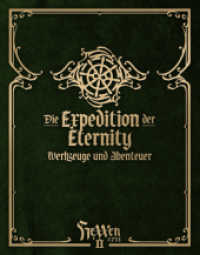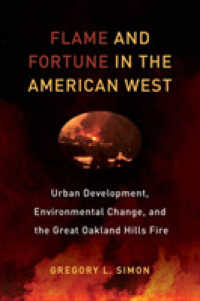Full Description
Teaching Social Studies: A Methods Book for Methods Teachers, features tasks designed to take preservice teachers deep into schools in general and into social studies education in particular. Organized around Joseph Schwab's commonplaces of education and recognizing the role of inquiry as a preferred pedagogy in social studies, the book offers a series of short chapters that highlight learners and learning, subject matter, teachers and teaching, and school context.
The 42 chapters describe tasks that the authors assign to their methods students as either in-class or as outside-of-class assignments. The components of each chapter are:
> Summary of the task
> Description of the exercise (i.e., what students are to do, the necessary resources, the timeframe for completion, grading criteria)
> Description of how students respond to the activity
> Description of how the task fits into the overall course
> List of readings and references
> Appendix that supplements the task description
Contents
Introduction: The Task of Teaching Social Studies Methods; S. G. Grant, John Lee, and Kathy Swan.
Part I. Learners and Learning.
Chapter 1. Raising Your Voice: Engaging the Social Studies Through Spoken Word Poetry; Lauren Bagwell and Brooke Blevins.
Chapter 2. Using Current Social Problems to Confront Pre-Service Teachers' Deficit Orientations of Their Candidates; Emilie M. Camp and Prentice T. Chandler.
Chapter 3. Practicing Deliberative Discussion: A Supportive Protocol; Todd Dinkelman.
Chapter 4. It's In the Bag: Alternative Assessment and the Brown Bag Exam; Jeremy Hilburn and Denise Ousley.
Chapter 5. Images of Africa: The Influence of Culture and Experience on Perceptions of Place; Hannah Kim.
Chapter 6. Becoming Critical Readers: Analyzing Authorship in Texts; Kimberly R. Logan, H. James Garrett, and Avner Segall.
Chapter 7. Starting Them Early: The Social Studies Needs Assessment Assignment; Starlynn Nance.
Chapter 8. Social Studies Through a Student's Eyes: Collaborative Action Research for Teachers and Students; Tony L. Talbert and Brooke E. Blevins.
Chapter 9. Reconnecting With Your Teenage Self; Scott Wylie.
Part II. Teachers and Teaching.
Chapter 10. Invitation to a Dinner Party: Learning About Social Studies Leaders; Chara Bohan.
Chapter 11. Lesson Plan Menu; Daniel T. Bordwell and Christopher H. Clark.
Chapter 12. Pedagogical Toolbox Analysis; Jonathan Ryan Davis and Maureen Connolly.
Chapter 13. Teacher Candidates Collaborate to Create an Interdisciplinary Assignment; Lorrei DiCamillo and Nancy M. Bailey.
Chapter 14. Using Video Stimulated Recall to Reflect on Teaching and Adapt to Candidate Needs; Jason L. Endacott.
Chapter 15. Feedback on Their Feedback; Brian Girard and Robert Bain.
Chapter 16. The Object of the Exercise: Increasing the Role of Museums in the Social Studies Classroom; Jill M. Gradwell and Kathryn H. Leacock.
Chapter 17. Cultivating Ambitious Practices: An Interdisciplinary Methods Model; Kevin W. Meuwissen and Jayne C. Lammers.
Chapter 18. Constructing Rationales to Teach Controversial Issues; Thomas Misco.
Chapter 19. Anticipating Social Studies Content; Kari Muente, Timothy Lintner, and Darren Minarik.
Part III. Subject Matter.
Chapter 20. Learning to Crosswalk: Horizon Content Knowledge in Economics; Cheryl A. Ayers.
Chapter 21. Maps and Apps for Responsible Consumer Literacy; Jason Harshman.
Chapter 22. History as Lived and Local; Jennifer Hauver.
Chapter 23. Documenting Democracy: The Digital Short Project; Todd S. Hawley.
Chapter 24. What Is Significant? Grappling with Pre-Service Teacher Perceptions of Historical Significance and Subject Content Knowledge; Aaron Johnson, David Hicks, and Stephanie van Hover.
Chapter 25. Doing Local History: An Exercise Using the C3 Framework for Social Studies Methods Courses; Michael P. Marino and Margaret Smith Crocco.
Chapter 26. Posting Perspectives: Evaluating Sources on Controversial Issues; Paul B. McHenry.
Chapter 27. What Should I Teach? Conceptualizing Subject Matter; Rebecca Mueller, Lauren Colley, and Emma Thacker.
Chapter 28. Methods of Integrating Current Events Into Social Studies Lessons; Jeff Passe.
Chapter 29. Problematizing the Social Studies; Mark Pearcy.
Chapter 30. Commitment to Social Justice Is Not Enough, Love Is Not Enough: Helping New Social Studies Teachers Develop Content Knowledge for Teaching; Dave Powell.
Chapter 31. Connecting Content to the World; Mardi Schmeichel.
Chapter 32. Teachers as Decision Makers: Using a Document-Based Activity Structure (DBAS) to Create Social Studies Curriculum; Corey R. Sell and Philip E. Bernhardt.
Chapter 33. Discussing Standards: A Dialogic Analysis of the NYS Social Studies Framework; Dennis Urban and Elina Lampert-Shepel.
Part IV. Context.
Chapter 34. An Hour in Our Town; Erin Adams.
Chapter 35. Experiencing a Different Field: Cultural Capital and the Classroom; Nick Bardo and Bárbara C. Cruz.
Chapter 36. Picturing Social Studies; Kristy A. Brugar.
Chapter 37. Community Mapping Video Podcast Project: Developing Teacher Candidates' Sociocultural Consciousness; Erik Jon Byker, Amy Good, and Nakeshia Williams.
Chapter 38. Troubling the Familiar: The Institutionalized Racism Inquiry Project; Alexander Cuenca.
Chapter 39. A Lived-In Secondary Social Studies Methods Course; Brad M. Maguth.
Chapter 40. Mentoring, Public Outreach, and Social Justice Issues: Ingredients for a Powerful Professional Partnership; Joe O'Brien and Tina M. Ellsworth.
Chapter 41. Tracking in Schools: Candidates Map Their Placement Context; Alexander Pope.
Chapter 42. Academic Profiles: Connecting Kids, Data, and Practice; Kent Willmann.
Biographies.








